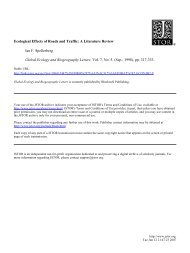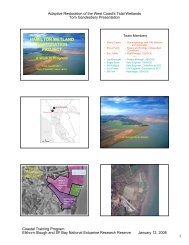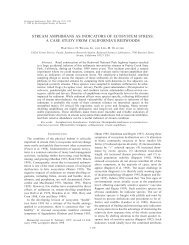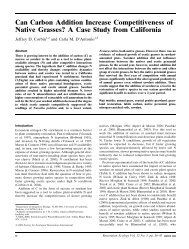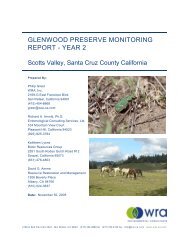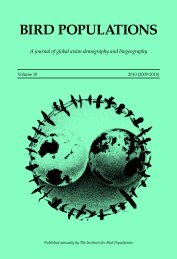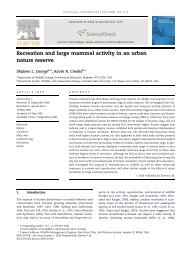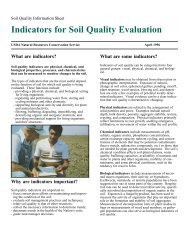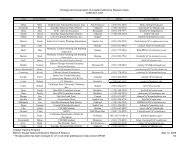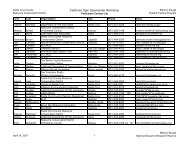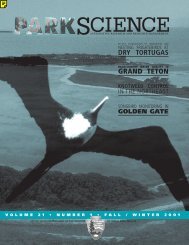Turning the Ship Around Changing the policies and culture of a ...
Turning the Ship Around Changing the policies and culture of a ...
Turning the Ship Around Changing the policies and culture of a ...
You also want an ePaper? Increase the reach of your titles
YUMPU automatically turns print PDFs into web optimized ePapers that Google loves.
current employees that <strong>the</strong> new ways were beneficial to <strong>the</strong>m <strong>and</strong> <strong>the</strong> department, <strong>and</strong><br />
develop <strong>and</strong> maintain an incredible communication system to continually reach 1600<br />
people.<br />
Finding "In House Cheerleaders"<br />
I got some really good advice from an old friend who said, "If you want to change a<br />
department as big as DNR, you can't do it from <strong>the</strong> top. You've got to have people at<br />
every level <strong>of</strong> <strong>the</strong> organization who are not only on your team but are your cheerleaders.<br />
If you can't find <strong>the</strong>m in <strong>the</strong> organization, <strong>the</strong>n get control <strong>of</strong> hiring <strong>and</strong> make sure you<br />
bring <strong>the</strong>m in at every level."<br />
Although <strong>the</strong> existing civil service system in Washington doesn't allow an agency<br />
director to "get control" <strong>of</strong> <strong>the</strong> hiring at every level, I was able to influence hiring<br />
decisions by being very specific about <strong>the</strong> effect that hiring good employees would have<br />
on a supervisor's evaluation for advancement.<br />
Ultimately, I went looking for specific individuals at each level <strong>of</strong> <strong>the</strong> department who<br />
would become <strong>the</strong> "in-house cheerleaders" for our proposed changes. In some instances<br />
that meant hiring new people, <strong>and</strong> in most it simply meant finding <strong>the</strong> employee who was<br />
willing to take a risk with his fellow workers, was curious about what we were doing, or<br />
simply was <strong>the</strong> recognized "leader <strong>of</strong> <strong>the</strong> gang," <strong>and</strong> converting him to our plan. In a<br />
small number <strong>of</strong> cases, I had to remove a person who was determined to go in ano<strong>the</strong>r<br />
direction.<br />
To recruit <strong>the</strong>se cheerleaders, we worked hard to make sure all employees understood<br />
how valuable <strong>the</strong>y were to <strong>the</strong> department <strong>and</strong> to our plans. We surveyed all employees<br />
<strong>and</strong> asked for <strong>the</strong>ir advice on key topics, <strong>and</strong> we established an employee advisory<br />
committee to work directly with executive management. Two actions that paid real<br />
dividends were <strong>the</strong>se:<br />
First, we ensured that <strong>the</strong> science group was led by scientists in <strong>the</strong> department. Both<br />
Chuck Turley <strong>and</strong> Lenny Young were highly regarded inside <strong>and</strong> outside <strong>the</strong> DNR. Their<br />
ability to discuss science in lay terms <strong>and</strong> to translate <strong>the</strong> scientific impacts <strong>of</strong> each policy<br />
option was absolutely <strong>the</strong> most important aspect <strong>of</strong> our entire plan. We were fortunate to<br />
have in our department two people with <strong>the</strong>se skills, <strong>and</strong> <strong>the</strong>y became our most important<br />
weapon in <strong>the</strong> science vs. politics battle. As scientists, <strong>the</strong>y had credibility everywherewith<br />
o<strong>the</strong>r scientists, with our employees, with policy makers, with our governing board,<br />
<strong>and</strong> with our adversaries. Because both were exceptionally skilled communicators, <strong>the</strong>y<br />
were able to translate <strong>the</strong>ir considerable knowledge into on-<strong>the</strong>-ground impacts <strong>of</strong> each<br />
choice, thus allowing <strong>the</strong> policy makers to know <strong>the</strong> ultimate results <strong>of</strong> <strong>the</strong> choices <strong>the</strong>y<br />
would make.<br />
Second, we placed a long-time employee <strong>of</strong> <strong>the</strong> department-one who had been part <strong>of</strong> <strong>the</strong><br />
"old ways" <strong>of</strong> doing things-in charge <strong>of</strong> plan development. We needed someone who<br />
understood how things had been done, <strong>and</strong> why, if we were to do <strong>the</strong>m differently. We



